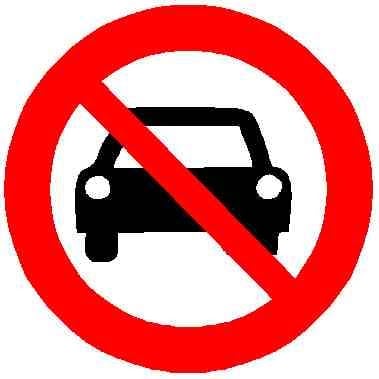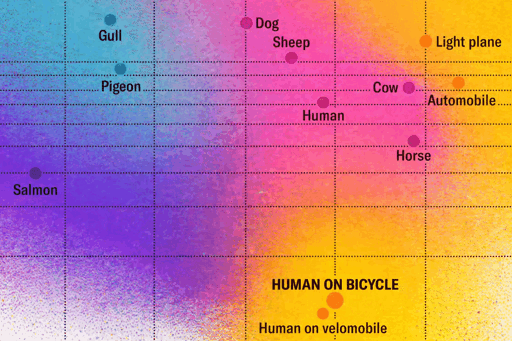Non paywalled version
Turns out a car is particularly inefficient… Who knew /s
who the fuck thought it was a good idea to put animated backgrounds on a graph
I love how the plot is pretty much normalized to pigeons
Yeah, but what about a bird on a bike?
Bike Bird! Coming to Tubi this Fall!
Gull or pigeon?
European swallow
quote of the day: “Bikes allow us terrestrial folk to be more like fish.”
Wasn’t there a quote about bicycles and fish?
Idk but there’s this

Humans aren’t very efficient movers.
Now that’s bullshit. Efficient walking is literally one of the few things we’re best at. Chasing prey to exhaustion is a hunting method we are made for.
Edit: right, movers, not walkers.
Compared to other things that walk, yes. Muscle efficiency is gutter tier shit in general. Internal combustion engines look good in comparison, and no, I’m not joking.
This is why e-bikes are the most efficient form of travel in terms of calories burned per km. Batteries and electric motors are about as efficient as anything can be, and it’s better when they’re not pushing around a large metal box.
In terms of lifetime CO2 output, though, they never quite catch up to regular bikes due to the extra manufacturing needs. It’s not a huge difference, though; if an e-bike is what gets people out of a car, that’s a massive win.
Yeah, according to that graph a human (on foot) is beaten only by salmon, horse, jet transport, and… humans b/w pedal power.
We’re never gonna beat salmon, they’re pretty much the ideal swimmers. We’re also never gonna beat horses, they’re superb.
I guess all that’s left is jetpacks /j
I mean, depends on how you compare it. A salmon on land is pretty inefficient. 😂
Uhm, horse? Moving 4 legs with hoofs vs. 2 in pendulum and with heels.
Damn, I always knew that humans are some of the most efficient beings on earth. Given the 100-200 watts we use a day powers one of the most evolved brains and one of the most capable bodies.
So it doesn’t surprise me that us, powering a more efficient vehicle (such as a bike) would result in some of the highest efficiency movement anywhere on earth
one of the most revoked brains
?
If you turn on the internet for a bit it makes sense.
I guarantee that’s not how it works.
Maybe you’re using the internet wrong?
I took three internets and woke up dead this morning
I’m sorry to hear that, feel better soon!
Ahahahaha autocorrect. “Evolved Brains”
“Velomobile”… one of those might solve literally all the reasons I currently need a car if it can hold enough luggage.
I would kinda like one, but from what I can tell they are not cheap.
I’m a big fan of bikes, I always ride locally. But I suspect this is assuming a paved road, and a well maintained bike, right? In wonder how that changes when you account for maintenance costs? Alternatively, what would mountain biking look like on this chart?
Edit: did I word it that badly? I mean, a bike is only that energy efficient because you’ve already spend a craptonne of energy building the smooth road. Comparing it to a person walking is not, unless you also do a comparison across rough terrain (that is still easily navigable by a person on foot)
Maintenance cost? It’s negligible. The cost of part and maintenance in a year, assuming you buy Decathlon stuff and do it yourself, will likely cost less than your fuel for your car in a month. Electric car might cost less with the maintenance, but the tire itself will also eat up the cost sooner or later.
Both type of car is also expensive to purchase, while on the other hand you can get a $300 Chinese bike, optimise it a bit, and it will go for years before you need to replace anything.
Much less than the fuel for the car, likely even less than the electricity for an electric car.
Road bike tires (the only kind you should use for commuting on paved roads) last between 2500 and 6500km. If you don’t skid while braking (which you shouldn’t ever do anyway) and use the correct pressure it’s easy to push that figure towards the top of the bracket.
Disk brake pads last between 8000 and 16000km.
Tubes last between 1500 and 8000km.
The chain lasts between 3000 and 5000km, and shifting correctly makes them last a lot longer.
If you shift correctly and replace the chain in time, the sprocket never wear out. I had a road bike from the 70s that I used quite heavily for about 10 years and it still had the original sprockets and shifters.
Pedals, cranks and bottom bracket also only fail if you abuse them (e.g. never shift).
Which leaves the pull wires (for breaks and shifters) and the grip tape, which both last very long and are very cheap.
All other parts only break when abused or in an accident.
So if we say you are commuting your bike and it’s 50km per day, 5 days a week without counting vacation and stuff, then that’s 13 000km.
That means:
- 3 sets of tires (6x€16)
- 1 set of brake pads (1x€7)
- 3 sets of tubes (3x€10)
- 3 chains (3x€10)
Prices are name-brand products from Amazon.
That’s €163 in total. You could probably even go cheaper than that, and 50km per day is quite a lot as well. If you take care of your bike, you can push the components much farther too, since I only took the average values.
A more likely value if you are careful while riding and maybe only commute 20km/day, you probably won’t have more maintainance cost than €40-50/year.
Maybe I wasn’t clear. I meant the maintenance cost for the road (and the bike, but I suspect the road is the bigger cost). Clarified in the original.
Also significantly less. The reason road needed to repair is usually caused by ground erosion(which will happened regardless), tree root damage(which will also happened regardless), and the vehicle(plus speed) moving above. The heavier the vehicle using it, the quicker the road will be damaged. The weight of a sedan + driver is usually 10 times or more heavier than bicycle + rider, and the speed of a car on the road is usually 3 to 4 times of the bike. Unless the bikelane is build on top of ground that is prone to movement or near a big tree, it will last way longer than the road build solely for car.
Good point, thanks
I doubt maintenance costs make much difference to the number of calories burned, although it might depend on how physical the job is that pays for maintenance.
Probably negligible though.
Embodied energy is a thing. For the bike and the road. Edited my comment for clarity.
The big difference is wear and tear. Some other article posted here a few days ago talked about this difference on road attrition. It takes one bicycle to go over a road 160 thousand times to cause the same damage to a road than a single car passing once.
So, building a smooth road for bicycles, which were lobbied for and constructed first for bikes waaaay before the first car was ever invented, has a lower cost and much better ROI than the same road being used by cars. Even in rough weather conditions. Also, I’m much more efficient on a mountain trail in a bike than any 4x4 truck.
True, that’s a great point
This is about energy expenditure while moving. So unless you are doing maintainance while on the bike, it doesn’t factor into the number.
To honestly compare the efficiency of cars you have to consider that the car might weigh 2000kg, but when it’s only transporting a 100kg occupant you have to divide the efficiency by 20. Only when you’re fully utilizing the vehicle to transport many passengers and cargo are you going to approach the efficiency values on the graph. All the vehicles have the same problem, they assume you’re not just trying to get to the destination, but that you also want to bring your mobile living room (with couch and recliners and HVAC system and a storage locker) to the destination as well.
By comparison, walking has the full efficiency since you’re transporting yourself in full to the destination.
False headline are not fun, a Pelican using the ground effect had to be way not efficient.
That’s like comparing only to a person on a bike downhill
Maybe compare to birds tracking upwards air currents to move while hovering, as they actually maintain a low average energy expenditure while moving
And even that would be similar to someone cycling uphill, supported by the wind. Using air currents is efficient, but requires there to be air currents to use.
Gliding is really efficient for the distance covered, however: rolling resistance of wheels and the air resistance of a (not as aerodynamic) person is higher (and hence less efficient) than birds.
Why have they done that with the largely meaningless background of the graph
They explain the meaning of the colors if you scroll down a bit…
I’m referring to the distracting and pointless animation of the background, not the meaning of the colours (which are used to shade largely meaningless areas of the graph)
Since when are lemmings heavier than salmon?











